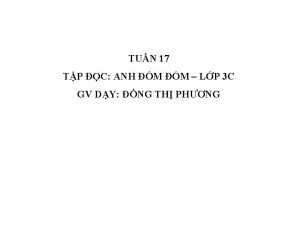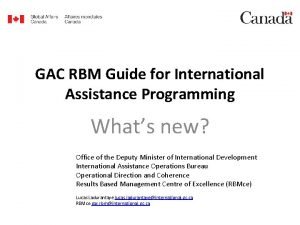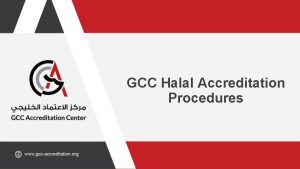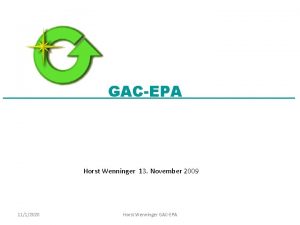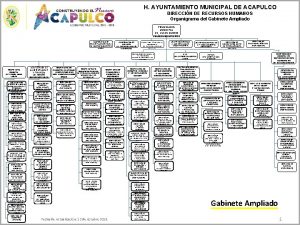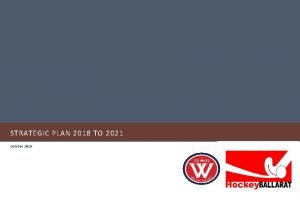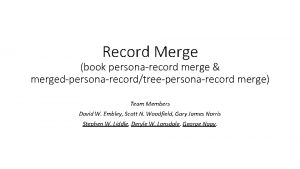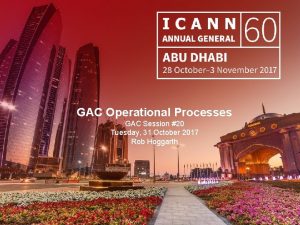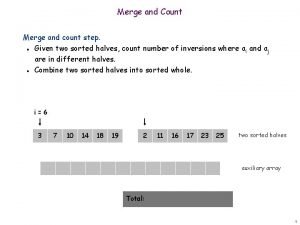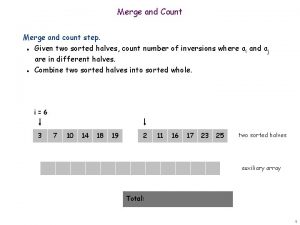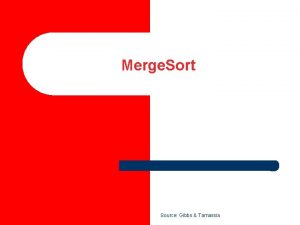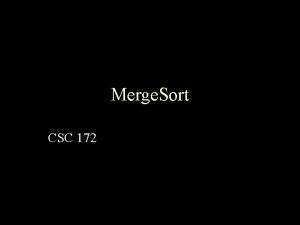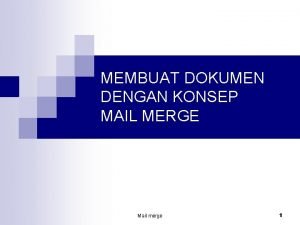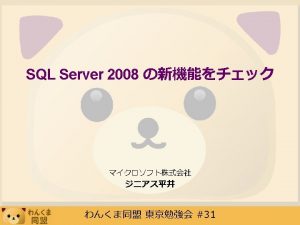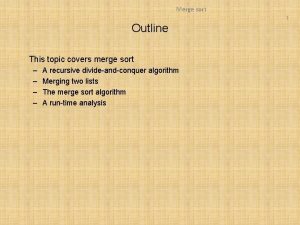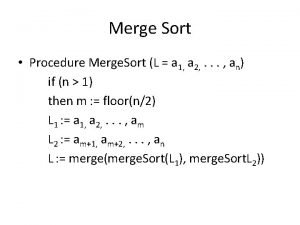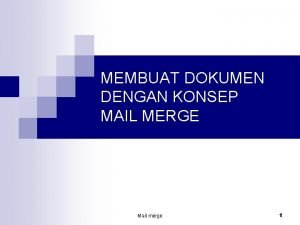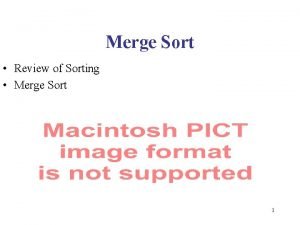MERGE 2018 2021 MERGE for GAC 19 20



















- Slides: 19

MERGE 2018 -2021 MERGE for GAC 19 -20 May 2010

MERGE: Strategic Research Area (SRA) “Mod. Elling the Regional and Global Earth system” MERGE for GAC 19 -20 May 2010

MERGE Goals ® Advance the state-of-the-art for representing biosphere-atmosphere forcing and feedbacks in Earth system (climate) models ® Contribute to national and international efforts to describe and attribute climate change, underpinning policy responses ® Foster a new generation of scientists skilled in Earth system science and climate modelling ® Improve the societal relevance of climate model-based research and results MERGE for GAC 19 -20 May 2010

Addressing the Challenges - Research themes of MERGE Theme 1 – ESM development Theme 2 – learning from the past palaeoclimate & land cover MERGE for GAC 19 -20 May 2010 climate-biosphere interactions Theme 3 – particles Theme 4 – statistics aerosol-climate parameterisations for ESMs new methods for ESM analysis and simulation

Some Recent MERGE Highlights • LPJ-GUESS coupled to EC-Earth and CMIP 6 preparation • Published RCA-GUESS results for Africa and the Arctic • Progress towards LPJ-GUESS v 4. 1 • Progress towards continental, multi-millennial land-use reconstruction using REVEALS • 1000 yr Fennoscandian summer drought variability analysis • Model and data-based reconstruction of NAO since 800 AD • EMEP modelling of SOA in China, and ozone damage to crops • Improvements to process descriptions relating to soot in the ADCHEM model • Aerosol workshop with a goal of bridging gaps between experiment, observations, detailed models and ESMs • Spatial and statistical reconstructions of past land cover • Statistical smoothing techniques for satellite-measured vegetation • Etc. MERGE for GAC 19 -20 May 2010

2018 and beyond? MERGE for GAC 19 -20 May 2010

Progress Toward a new Strategy Document • Why does MERGE need to update its strategy? • End of start-up phase, time to consolidate, e. g. model integration and use • And to think about how to meet new challenges, scientific and societal • Important for focus, inclusion and participation • A decision was made by the Board to draft a strategy document • So a survey with specific questions was sent to board members… • … followed by a meeting in Landskrona • More input to be gathered at this autumn meeting • Draft document will be made available for comment in December MERGE for GAC 19 -20 May 2010

Main Points of Discussion • Visions and research questions • Swedish and global context and developments • Promoting better Research Area cooperation • From process models to Earth System Models (ESMs) • Infrastructure • Education at BSc, MSc levels • Research Education • Improved stakeholder interaction and outward communication MERGE for GAC 19 -20 May 2010

Main points MERGE for GAC 19 -20 May 2010

Visions • The vision of MERGE is to establish and develop a major multidisciplinary climate/Earth System modelling node with world leading science and research education on climate/terrestrial biosphere interactions (including vegetation, land use, biogeochemical cycles and aerosols). This is accompanied by societal dialogue in the spirit of social learning by both scientists and stakeholders. To be replaced with • The vision of MERGE is to be a Swedish node for multidisciplinary research on and using climate/Earth System modelling, working with the international Earth System modelling community and its science agenda. MERGE encompasses world leading research and research education on climate-terrestrial biosphere interactions (including forcings and feedbacks of vegetation, land use, biogeochemical cycles and aerosols). This is accompanied by societal dialogue in the spirit of social learning by both scientists and stakeholders. MERGE for GAC 19 -20 May 2010

Research Questions • How sensitive is the global climate system to emissions and land use change? • How do Earth System feedbacks modify the global, regional and local climate response? • Can remaining uncertainties on climate sensitivity be further reduced? These are quite general and could apply to many other environments. One idea is to include detailed sub-questions that are more in line with out specific research, e. g. • What are links between air quality, food production, climate change and biosphere-atmosphere interactions? • How has the openness of the European landscape altered local climate? • How do land use policies to meet Paris A goals alter local climate? MERGE for GAC 19 -20 May 2010

Swedish and global context and developments • Paris agreement and the policies this can result in • Mitigation and adaptation strategies such as BECCS and land use • But how do such policies and technologies actually affect the climate, locally and globally, including not just the C cycle, but also BVOCs, aerosols, albedo etc. • Swedish context – the climate policy framework from summer 2017 and use of local knowledge relating to energy and land use • CMIP 6 • IPCC AR 6 and special reports • Agenda 2030 and policies relating to air pollution, health etc. MERGE for GAC 19 -20 May 2010

Promoting RA cooperation to address the Research Questions • Keep the existing RA structure but improve links and cooperation • Also implies better cooperation between partners • Lots of good examples and ongoing activities • Budget 2018 and 2019 will include targeted funds for workshops and for smaller internal calls with this issue in mind • Workshop ideas discussed here and by the Board • Can result in papers, improved process descriptions, common applications, case studies etc. • Cooperation across RAs in response to relevant funding calls, e. g FORMAS MERGE for GAC 19 -20 May 2010

From process models to Earth System Models (ESMs) • Modelling ”chain” discussed at the MERGE aerosol workshop • Highly complex task since models vary widely in their range of spatial and temporal applicability and interest • Can we take ESM descriptions (e. g. SOA scheme in EC-Earth) and include them in EMEP? • We can refine the descriptions in complex models by running them for shorter time periods and for single columns/over limited areas. Here, detailed observation data is vital – links to ACTRIS, ICOS etc • Human resources and expertise needed. • Other examples from interactions with BECC, e. g. soil microbial processes in ESMs via LPJ-GUESS MERGE for GAC 19 -20 May 2010

Infrastructure • Examples: supercomputers (HPC), ACTRIS, cloud chambers, ICOS, measurements campaigns in India, China, Africa, Tropical forests • Access to HPC vital to the CMIP 6 effort • Active collaboration with SMHI, Stockholm Univ. via S-CMIP, Nordic ESM • Planned white paper on a vision for climate system modelling MERGE for GAC 19 -20 May 2010

Education at BSc, MSc (GU) and Ph. D (FU) Levels • Greater MERGE involvement in GU vital to the education of next generation of climate experts, but also business leaders, decision makers etc. • Inventory in Gothenburg – other partners too? • Open. IFS and Ed. GCM now being used at MSc and Ph. D levels • BECC/MERGE ”Climate MSc” still a vision • Clim. BEco vital! • Need greater MERGE involvement in Clim. BEco courses and annual meetings • MERGE contact person nominated MERGE for GAC 19 -20 May 2010

Improved stakeholder interaction and outward communication • MERGE provides input to knowledge syntheses, e. g IPCC • Also concrete results that end up on dataservers, e. g. CMIP 6 ESGF • Often, demand is for climate knowledge and understanding, not specific results. This also links to education. • Policy briefs: stakeholders and others can request policy briefs, or we can write them for release in connection with larger events that will attract media attention, e. g. release of IPCC 1. 5 C Report in 2018 • Easier to find stakeholders in the area of air quality • Example: Vattenhallen in Lund – together with BECC • SRG and process currently being updated • Cooperation is vital for success, and evaluations! • The Board stress the importance of interaction with BECC and Bolin Centre. Joint annual meetings and/or strategic meetings. • Nordic ESM also a vital platform for cooperation. MERGE for GAC 19 -20 May 2010

Next steps • Draft strategy document to be circulated in December • Comments welcome! • Agreed by the Board in January Foto: M Rummukainen MERGE for GAC 19 -20 May 2010

Tack! MERGE for GAC 19 -20 May 2010
 Mặt trời gác núi
Mặt trời gác núi Mặt trời gác núi bóng tối lan dần
Mặt trời gác núi bóng tối lan dần Gac rbm
Gac rbm Gac halal
Gac halal Cili fruit
Cili fruit Gâc
Gâc 1112020
1112020 Que letra continua m v t m j
Que letra continua m v t m j Organigrama del gobierno municipal de acapulco
Organigrama del gobierno municipal de acapulco Strategic plan 2018 to 2021
Strategic plan 2018 to 2021 Bamse för de yngsta
Bamse för de yngsta Verktyg för automatisering av utbetalningar
Verktyg för automatisering av utbetalningar Bo bergman jag fryser om dina händer
Bo bergman jag fryser om dina händer Kanaans land
Kanaans land Aktiv expektans
Aktiv expektans Stig kerman
Stig kerman Strategi för svensk viltförvaltning
Strategi för svensk viltförvaltning Sju för caesar
Sju för caesar Ledningssystem för verksamhetsinformation
Ledningssystem för verksamhetsinformation Matematisk modellering eksempel
Matematisk modellering eksempel
